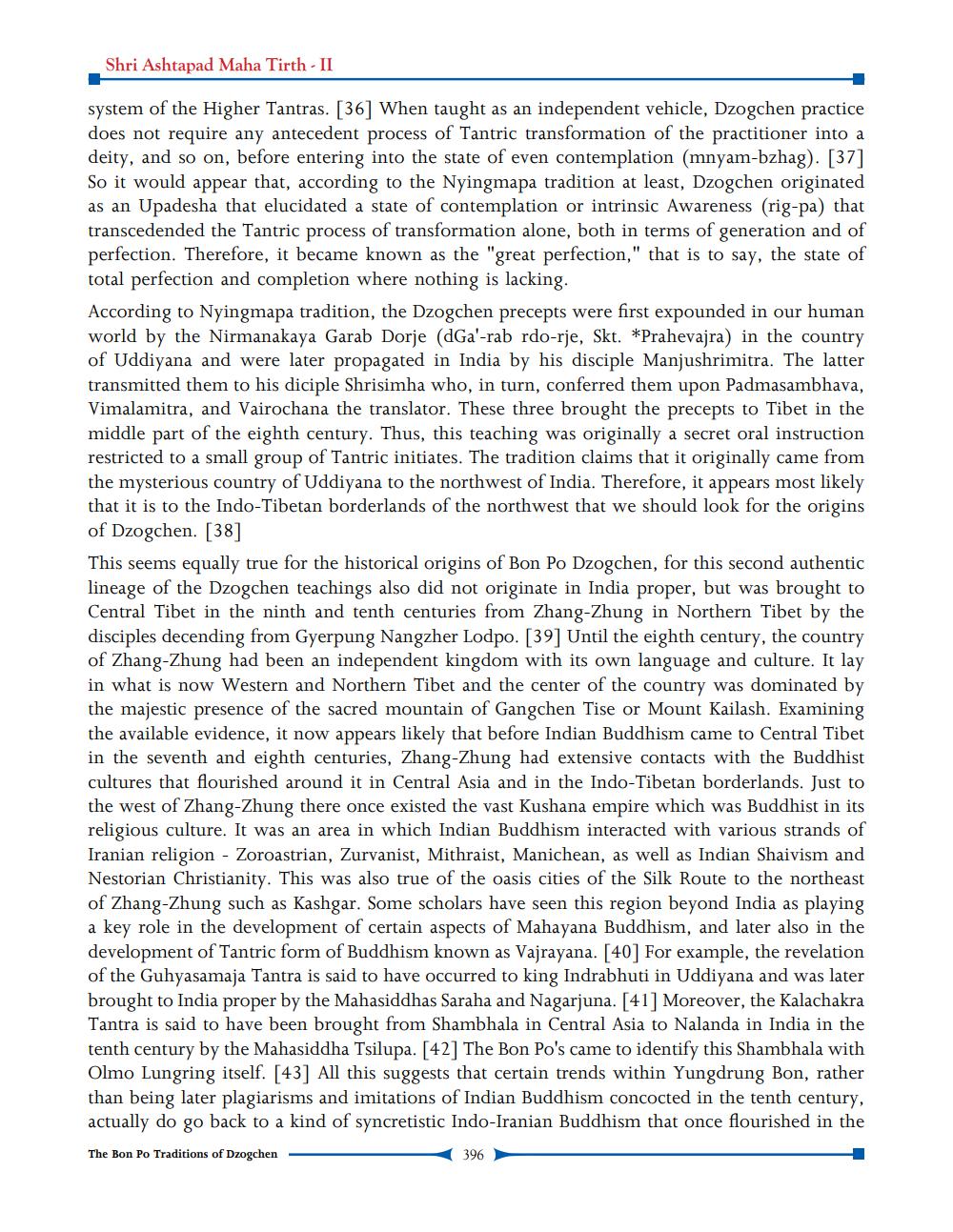________________
Shri Ashtapad Maha Tirth - II
system of the Higher Tantras. [36] When taught as an independent vehicle, Dzogchen practice does not require any antecedent process of Tantric transformation of the practitioner into a deity, and so on, before entering into the state of even contemplation (mnyam-bzhag). [37] So it would appear that, according to the Nyingmapa tradition at least, Dzogchen originated as an Upadesha that elucidated a state of contemplation or intrinsic Awareness (rig-pa) that transcedended the Tantric process of transformation alone, both in terms of generation and of perfection. Therefore, it became known as the "great perfection," that is to say, the state of total perfection and completion where nothing is lacking. According to Nyingmapa tradition, the Dzogchen precepts were first expounded in our human world by the Nirmanakaya Garab Dorje (dGa'-rab rdo-rje, Skt. *Prahevajra) in the country of Uddiyana and were later propagated in India by his disciple Manjushrimitra. The latter transmitted them to his diciple Shrisimha who, in turn, conferred them upon Padmasambhava, Vimalamitra, and Vairochana the translator. These three brought the precepts to Tibet in the middle part of the eighth century. Thus, this teaching was originally a secret oral instruction restricted to a small group of Tantric initiates. The tradition claims that it originally came from the mysterious country of Uddiyana to the northwest of India. Therefore, it appears most likely that it is to the Indo-Tibetan borderlands of the northwest that we should look for the origins of Dzogchen. [38] This seems equally true for the historical origins of Bon Po Dzogchen, for this second authentic lineage of the Dzogchen teachings also did not originate in India proper, but was brought to Central Tibet in the ninth and tenth centuries from Zhang-Zhung in Northern Tibet by the disciples decending from Gyerpung Nangzher Lodpo. [39] Until the eighth century, the country of Zhang-Zhung had been an independent kingdom with its own language and culture. It lay in what is now Western and Northern Tibet and the center of the country was dominated by the majestic presence of the sacred mountain of Gangchen Tise or Mount Kailash. Examining the available evidence, it now appears likely that before Indian Buddhism came to Central Tibet in the seventh and eighth centuries, Zhang-Zhung had extensive contacts with the Buddhist cultures that flourished around it in Central Asia and in the Indo-Tibetan borderlands. Just to the west of Zhang-Zhung there once existed the vast Kushana empire which was Buddhist in its religious culture. It was an area in which Indian Buddhism interacted with various strands of Iranian religion - Zoroastrian, Zurvanist, Mithraist, Manichean, as well as Indian Shaivism and Nestorian Christianity. This was also true of the oasis cities of the Silk Route to the northeast of Zhang Zhung such as Kashgar. Some scholars have seen this region beyond India as playing a key role in the development of certain aspects of Mahayana Buddhism, and later also in the development of Tantric form of Buddhism known as Vajrayana. [40] For example, the revelation of the Guhyasamaja Tantra is said to have occurred to king Indrabhuti in Uddiyana and was later brought to India proper by the Mahasiddhas Saraha and Nagarjuna. [41] Moreover, the Kalachakra Tantra is said to have been brought from Shambhala in Central Asia to Nalanda in India in the tenth century by the Mahasiddha Tsilupa. [42] The Bon Po's came to identify this Shambhala with Olmo Lungring itself. [43] All this suggests that certain trends within Yungdrung Bon, rather than being later plagiarisms and imitations of Indian Buddhism concocted in the tenth century, actually do go back to a kind of syncretistic Indo-Iranian Buddhism that once flourished in the The Bon Po Traditions of Dzogchen
396




